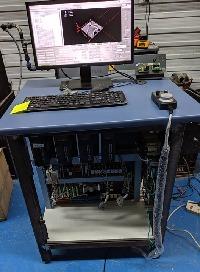THCAD and Arc Voltages
- snowgoer540
-
 Topic Author
Topic Author
- Offline
- Moderator
-

- Posts: 2501
- Thank you received: 841
Yes you can make any input range you like by changing the through hole resistors.
All 300K = 300V full scale
all 4.99K = 5V full scale
all 10K = 10V full scale
These should be 1% or better resistors
Any reason why we couldn't put 10K resistors in parallel with the existing 10K resistors essentially making it 5K THCAD-5?
I want to use it for ohmic sensing.
It’s unclear what you have now. If you want to use a thcad-10 for ohmic with the 24v power supply, just use a 140k scaling resistor in place of the 390k for a thcad-5
Please Log in or Create an account to join the conversation.
- bevins
-

- Offline
- Platinum Member
-

- Posts: 1942
- Thank you received: 338
Yes you can make any input range you like by changing the through hole resistors.
All 300K = 300V full scale
all 4.99K = 5V full scale
all 10K = 10V full scale
These should be 1% or better resistors
Any reason why we couldn't put 10K resistors in parallel with the existing 10K resistors essentially making it 5K THCAD-5?
I want to use it for ohmic sensing.
It’s unclear what you have now. If you want to use a thcad-10 for ohmic with the 24v power supply, just use a 140k scaling resistor in place of the 390k for a thcad-5
I have a thcad-10 that I will use for THC. I want to use thcad-5 for ohmic sensing. I have another thcad-10 I want to convert to thcad-5 for ohmic sensing.
Please Log in or Create an account to join the conversation.
- snowgoer540
-
 Topic Author
Topic Author
- Offline
- Moderator
-

- Posts: 2501
- Thank you received: 841
Yes you can make any input range you like by changing the through hole resistors.
All 300K = 300V full scale
all 4.99K = 5V full scale
all 10K = 10V full scale
These should be 1% or better resistors
Any reason why we couldn't put 10K resistors in parallel with the existing 10K resistors essentially making it 5K THCAD-5?
I want to use it for ohmic sensing.
It’s unclear what you have now. If you want to use a thcad-10 for ohmic with the 24v power supply, just use a 140k scaling resistor in place of the 390k for a thcad-5
I have a thcad-10 that I will use for THC. I want to use thcad-5 for ohmic sensing. I have another thcad-10 I want to convert to thcad-5 for ohmic sensing.
I guess what I’m saying is you don’t have to. Just use a different scaling resistor and change the settings to match in the Hal file for the comp.
Please Log in or Create an account to join the conversation.
- bevins
-

- Offline
- Platinum Member
-

- Posts: 1942
- Thank you received: 338
Yes you can make any input range you like by changing the through hole resistors.
All 300K = 300V full scale
all 4.99K = 5V full scale
all 10K = 10V full scale
These should be 1% or better resistors
Any reason why we couldn't put 10K resistors in parallel with the existing 10K resistors essentially making it 5K THCAD-5?
I want to use it for ohmic sensing.
It’s unclear what you have now. If you want to use a thcad-10 for ohmic with the 24v power supply, just use a 140k scaling resistor in place of the 390k for a thcad-5
I have a thcad-10 that I will use for THC. I want to use thcad-5 for ohmic sensing. I have another thcad-10 I want to convert to thcad-5 for ohmic sensing.
I guess what I’m saying is you don’t have to. Just use a different scaling resistor and change the settings to match in the Hal file for the comp.
OK cool.
Is there a requirement to update firmware for a 7i92-7i76 for use with Hypersensing with thcad?
Please Log in or Create an account to join the conversation.
- bevins
-

- Offline
- Platinum Member
-

- Posts: 1942
- Thank you received: 338
The drawing is showing +24v and -24v.
Please Log in or Create an account to join the conversation.
- PCW
-

- Offline
- Moderator
-

- Posts: 17440
- Thank you received: 5087
Is there a requirement to update firmware for a 7i92-7i76 for use with Hypersensing with thcad?
Yes, you should use 7i92_7i76x1dpl.bit (which has 3 encoders with 'A' inputs on the 7I76's encoder connection)
Please Log in or Create an account to join the conversation.
- tommylight
-

- Away
- Moderator
-

- Posts: 20983
- Thank you received: 7154
Normal 24V power supply.The isolated power supply, Do I need +24 and -24 or just 24vdc with com?
The drawing is showing +24v and -24v.
Please Log in or Create an account to join the conversation.
- bevins
-

- Offline
- Platinum Member
-

- Posts: 1942
- Thank you received: 338
Is there a requirement to update firmware for a 7i92-7i76 for use with Hypersensing with thcad?
Yes, you should use 7i92_7i76x1dpl.bit (which has 3 encoders with 'A' inputs on the 7I76's encoder connection)
I cant file the bit file. Do you have a link to the bitfile?
Nevermind, I found it.
Please Log in or Create an account to join the conversation.
- robertspark
- Offline
- Platinum Member
-

- Posts: 915
- Thank you received: 216
What do you understand by 50:1 voltage divider?
I believe most people think, that if you sense 50volts at the input, you will get 1 volt at the output.
I too thought this..... afterall its a ratio,,,,,
the thing is the ratio is NOT input to output voltage.......
it is actually the voltage divider ratio [i.e. the ratio of the big resistor to the little resistor.....]
If you look at the schematic for the hypertherm powermax 45 (nonXP) you will see that there is a 100K and a 2K voltage divider arrangement which provides the standard 50:1 voltage divider output of the PMX45
The PMX45xp, 65, 85 and 105 have a different voltage divider arrangement and different resistances..... but the same principle applies..... its NOT the INPUT : OUTPUT voltage ratio, but the ratio of resistances.......
Back to the PMX45 for a moment......... 100K + 2 K = 102K
300V INPUT / 102K = 0.0294117647A
0.00294117647 x 2K = 5.88235294118V
so.... if the input voltage is 300V, with a PMX45, the output voltage at the CPC will be 5.88.xxxxV
therefore 300 / 5.88235294118 = 51
So, the input to output ratio on VOLTAGES is actually 51:1..... (300v in = 5.88...v out)
Ok, there is obviously some tollerance in the resistances used (5%, 1%, 0.1% whatever)..... ignoring that and presuming that they used high quality resistors (0.1%).... the ratio of input to putput voltages still stands.....
Going back to the first post and multiplying the OUTPUT (MEASURED) VOLTAGE by 51 this time and you will see you are bang on the "AVERAGE" number now (at least on the 50:1 line)
Note ...... if the resistance ratios are 50:1 (the VOLTAGE ratio is 51:1)..... same for 20:1..... the VOLTAGE ratio is 21:1.....
I can only speak about hypertherm and what I've observed about their resistance ratios.... I do not know enough about the other manufacturers (as their service manuals are poor IMHO)....... but if someone has the time to take the cover off their machine and take some close up photos of their voltage divider I'm happy to help (or eat my socks if I'm wrong)
Please Log in or Create an account to join the conversation.
- robertspark
- Offline
- Platinum Member
-

- Posts: 915
- Thank you received: 216
last page of PDF, bottom RHS, CPC pins 5 and 6, 100K (3W) and 2K
[note, the thing is as far as I am aware you don't get a 100K 3W resistor which is "precision" .... they all seem to be 5% tolerance, or worse]
I made a precision voltage divider for someone recently using precision resistors as a plugin kit for an old PMX1250 (that did not have a voltage divider) and I used 5x20K 0.1% precision resistors and a 2K 0.1% resistor as he wanted a 50:1 ratio output for a miniTHC, complete with all connectors to plug straight into the CPC and onto the PMX1250 PCB
______________________________________
bit more info on the other (PMX45xp, 65, 85 and 105 voltage divider resistors
www.plasmaspider.com/viewtopic.php?f=60&t=30784 (the secondary resistors are run in parallel via dip switches to the secondary resistor to give the different output ratios)
Please Log in or Create an account to join the conversation.
